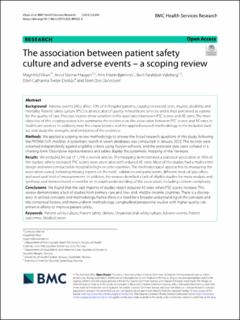| dc.contributor.author | Vikan, Magnhild | |
| dc.contributor.author | Haugen, Arvid Steinar | |
| dc.contributor.author | Bjørnnes, Ann Kristin | |
| dc.contributor.author | Valeberg, Berit Taraldsen | |
| dc.contributor.author | Deilkås, Ellen Catharina Tveter | |
| dc.contributor.author | Danielsen, Stein Ove | |
| dc.date.accessioned | 2024-02-02T10:02:08Z | |
| dc.date.available | 2024-02-02T10:02:08Z | |
| dc.date.created | 2023-03-29T11:38:24Z | |
| dc.date.issued | 2023 | |
| dc.identifier.issn | 1472-6963 | |
| dc.identifier.uri | https://hdl.handle.net/11250/3115232 | |
| dc.description.abstract | Background Adverse events (AEs) affect 10% of in-hospital patients, causing increased costs, injuries, disability and mortality. Patient safety culture (PSC) is an indicator of quality in healthcare services and is thus perceived as a proxy for the quality of care. Previous studies show variation in the association between PSC scores and AE rates. The main objective of this scoping review is to summarise the evidence on the association between PSC scores and AE rates in healthcare services. In addition, map the characteristics and the applied research methodology in the included studies, and study the strengths and limitations of the evidence. Methods We applied a scoping review methodology to answer the broad research questions of this study, following the PRISMA-ScR checklist. A systematic search in seven databases was conducted in January 2022. The records were screened independently against eligibility criteria using Rayyan software, and the extracted data were collated in a charting form. Descriptive representations and tables display the systematic mapping of the literature. Results We included 34 out of 1,743 screened articles. The mapping demonstrated a statistical association in 76% of the studies, where increased PSC scores were associated with reduced AE rates. Most of the studies had a multicentre design and were conducted in-hospital in high-income countries. The methodological approaches to measuring the association varied, including missing reports on the tools` validation and participants, different medical specialties, and work unit level of measurements. In addition, the review identified a lack of eligible studies for meta-analysis and synthesis and demonstrated a need for an in-depth understanding of the association, including context complexity. Conclusions We found that the vast majority of studies report reduced AE rates when PSC scores increase. This review demonstrates a lack of studies from primary care and low- and- middle-income countries. There is a discrepancy in utilised concepts and methodology, hence there is a need for a broader understanding of the concepts and the contextual factors, and more uniform methodology. Longitudinal prospective studies with higher quality can enhance efforts to improve patient safety. | en_US |
| dc.language.iso | eng | en_US |
| dc.rights | Navngivelse 4.0 Internasjonal | * |
| dc.rights.uri | http://creativecommons.org/licenses/by/4.0/deed.no | * |
| dc.subject | Pasientsikkerhetskultur | en_US |
| dc.subject | Patient safety culture | en_US |
| dc.subject | Helsevitenskap | en_US |
| dc.subject | Health sciences | en_US |
| dc.subject | Pasientsikkerhet | en_US |
| dc.subject | Patient safety | en_US |
| dc.subject | Uønskede hendelser | en_US |
| dc.subject | Uønskede hendelser | en_US |
| dc.title | The association between patient safety culture and adverse events - a scoping review | en_US |
| dc.type | Peer reviewed | en_US |
| dc.type | Journal article | en_US |
| dc.description.version | publishedVersion | en_US |
| cristin.ispublished | true | |
| cristin.fulltext | original | |
| cristin.qualitycode | 2 | |
| dc.identifier.doi | 10.1186/s12913-023-09332-8 | |
| dc.identifier.cristin | 2138036 | |
| dc.source.journal | BMC Health Services Research | en_US |
| dc.source.volume | 23 | en_US |
| dc.source.issue | 1 | en_US |
| dc.relation.project | OsloMet - storbyuniversitetet: 10910 Forskningsdatabasen OsloMet | en_US |

